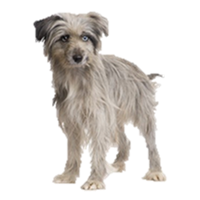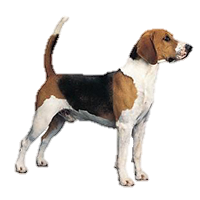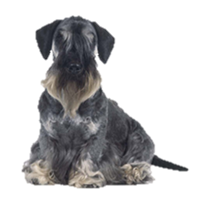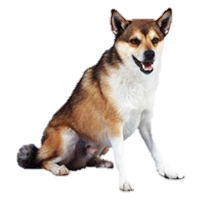|
Throughout the centuries the name spaniel has been given to more than a dozen breed of dogs, but when asked how many spaniels there are in the world of dogs that question can be hard to answer. It all depends on who you ask and which spaniels you want to count. Trying to use the title only makes it more difficult because breeds like the Tibetan Spaniel are not spaniels at all - but the little known Kooikerhondje is. To add another level of confusion the Brittany Spaniel in its homeland of France it is still known as the Epagneul Breton, but in the United States the spaniel was dropped. Why?
Perhaps we should start with what makes a spaniel a spaniel. The easiest answer would be spaniels were traditionally bred and trained to flush prey for hunters, but small companion dogs have also existed for just as long which are clearly spaniels. These dogs all share the same root ancestry and appearance, but their actual origin is unknown. Most scholars point to Spain, from the French word epagneul, but other theories involving Romans and Celts also exist. Due to the size of this question we will explore this family grouping in separate posts through over several days by looking at the early spaniels decedents both through type (appearance) as well as function. To simplify we have divided the spaniels into four groups: flushing, companion, non-flushing, and water. This specific post will explore the “true” spaniels – those that were specifically developed for flushing. There are seven breeds in this grouping, five of which hail from England. Each of these dogs descends directly from the early land spaniels and includes the English and Welsh Springers, English and American Cockers, Clumber, Sussex, and Field. These dogs are a tight grouping, beginning with the English Springer and English Cocker. These two were once so closely related that they were considered the same breed, separated only by size. Larger dogs were destined to become Springing Spaniels (also known at the time as Hawking or Starter) while their smaller littermates became Cocking Spaniels. It wasn't until the late 1800s that attempts were formally made to separate the two sizes. The English Cocker would also lead directly to the development of the Field Spaniel (due to breeders wanting a solid and slightly larger spaniel) and the American Cocker in the United States. The American Cocker is the only dog in this group that developed away from a hunting breed to become solely used as an companion. It was separated from the English Cocker by the American Kennel Club (AKC) in 1946. Ironically both of these dogs are known simply as 'Cocker Spaniel' in it's homeland, while the foreign cousin is give the title American or English. It is believed the Sussex and Clumber were created from crosses with the English Springer and hounds (the Clumber's hound addition being French rather than English). Both of these breeds came close to extinction after WWII and although they were saved their numbers have never truly recovered. Both are listed in their homeland as Vulnerable Native Breeds by the Kennel Club (KC) and the Sussex has been in the bottom ten of AKC registrations for several years. The only dog that may or not share these close relations is the Welsh Springer, which many experts believe to be older than the English breeds. It is mentioned in texts dating from the early 10th century, long before any documentation of spaniels in England.
1 Comment
Once again the American Kennel Club (AKC) has released the most popular dog breeds in the United States according to their registrations. No dog lover was surprised to find the Labrador Retriever once again led the pack while the Golden Retriever and German Shepherd Dog rounded out the top three out of 178 recognized breeds. Aside from the recent rise in the French Bulldog it was a fairly predictable list - but what about the dogs at the bottom of the list? Are these dogs simply new breeds or falling out of favor? Certainly many of their fanciers would tell you they like their dogs being 'unpopular' as over and ill breeding plagues many top breeds. However, these numbers have a downside, as they dip too low it also affects the breeding pool. In our article we will take a closer look at the bottom ten breeds individually, both by the numbers and as a chance to get to know some 'uncommon' breeds.  #169 - Sussex Spaniel 2013 - #162 2009 - #159 The Sussex Spaniel was developed in the late 18th and early 19th century by A.E. Fuller in Sussex, England. After his death the breed became scarce and barely escaped extinction after WWII thanks to Joy Freer. Despite being saved their numbers have never been strong. In its homeland the Sussex is even more uncommon and is listed with The Kennel Club's (KC) as a Vulnerable Native Breed.  #170 - Canaan Dog 2013 - #164 2009 - #156 In the 1930s Rudolphina Menzel became fascinated with primitive dogs that had survived outside of human intervention in the Negev Desert. Through careful breeding and domestication she adapted these pariah dogs for military work. The Canaan Dog was first recognized by the Israel Kennel Club in 1973, but was not accepted by the AKC until 1989. It is estimated they number between 1200-1400 worldwide.  #171 - Skye Terrier 2013 - #161 2009 - #155 Legend states that the Skye Terrier owes its existence to a Spanish shipwreck that brought a Maltese off the coast of the Isle of Skye which bred with local terriers in the 1600s. Some have suggested that Welsh Corgis or the Swedish Vallhund may have been used in their development. Like the Sussex Spaniel, the Skye Terrier is also listed by the KC as a Vulnerable Native Breed.  #172 - Pyrenean Shepherd 2013 - #169 2009 - #107 The Pyrenean Shepherd has worked with sheep in the Pyrenees Mountains of France for centuries alongside the Great Pyrenees. It is possible that another French herder, the Briard, was used in their development. In their homeland this is a common breed, both as a companion and as a working dog.  #173 - Otterhound 2013 - #172 2009 - #161 Possibly one of the rarest dog breeds today, the Otterhound has existed since the 13th century. Huge packs used to exist throughout England, tasked with hunting the 'vermin' otter from fishing waters. When the killing of otters was outlawed in 1978 this breed no longer had a place in the modern world. Another Vulnerable Native Breed only 22 pups were born in the United Kingdom in 2014.  #174 - American Foxhound 2013 - #176 2009 - #162 The American Foxhound was bred from several European hounds in the 1600s, its main ancestor being the English Foxhound. While AKC registrations are low it is important to note that many American hunting dogs are registered with the United Kennel Club (UKC) rather than the AKC and some packs are not registered with either club.  #175 - Harrier 2013 - #173 2009 - #163 The Harrier may be the oldest surviving scenthound with a documented pack tracing back to 1260. Although never recognized by the KC this breed does still exist in the United Kingdom. Its stronghold is Northern Ireland, where fox hunting is still legal and this breed is the locals' favorite hound for the sport. It is estimated at least 100 packs still exist there.  #176 - Cesky Terrier 2013 - #174 2009 - Unrecognized A fairly 'new' breed, the Cesky Terrier was not created until after WWII and was not recognized by the AKC until 2011. Still gaining a foothold in the United States it is the National Dog of the Czech Republic and not considered rare in its homeland.  #177 - English Foxhound 2013 - #177 2009 - #164 The English Foxhound has existed since the late 16th century and although fox hunting is outlawed in its homeland it is not considered in danger there. Like the American Foxhound a large number of these dogs in the United States are actually registered through the UKC.  #178 - Norwegian Lundehund 2013 - #175 2009 - Unrecognized Norwegian Lundehund's were originally developed to hunt puffins off the coasts of Norway and were used extensively for this purpose from the 1600-1800s. One puffin hunting became illegal the breed became rare and was almost extinct after WWII and two distemper outbreaks. Today there are somewhere between 1500-2000 dogs worldwide, most remaining in Norway. In the end popularity really comes down to where you are located (although the Labrador Retriever still reigns supreme in many countries). Most of these 'rare' breeds still have high numbers in their homelands, or even with other kennel clubs in the United States. Of these ten only three breeds (all from the United Kingdom) have dangerously low counts worldwide - the Sussex Spaniel, Skye Terrier and Otterhound.
To many this may seem the word endangered or vulnerable is too harsh to use to describe a dog breed, as they are all one species. After all, what place does a dog bred to hunt otters have in the modern world? Still, they are a living piece of history and to their fanciers they are the only breed that matters. |
AuthorLisa Quibell Archives
March 2019
Categories
All
|
- Home
- Worldly Dogs Blog
-
Breeds Geographically
- Africa >
-
Asia
>
- Australia >
-
Europe
>
- Austria >
- Belgium >
- Bosnia and Herzegovina >
- Croatia >
- Czech Republic >
- Denmark >
-
England
>
- Airedale Terrier
- Basset Hound
- Beagle
- Bedlington Terrier
- Border Collie
- Border Terrier
- Bull Terrier
- Bulldog
- Bullmastiff
- Cavalier King Charles Spaniel
- Clumber Spaniel
- Curly Coated Retriever
- English Cocker Spaniel
- English Foxhound
- English Setter
- English Springer Spaniel
- English Toy Spaniel
- Field Spaniel
- Flat Coated Retriever
- Greyhound
- Harrier
- Jack Russell Terrier
- Lakeland Terrier
- Lancashire Heeler
- Manchester Terrier
- Mastiff
- Miniature Bull Terrier
- Norfolk Terrier
- Norwich Terrier
- Old English Sheepdog
- Otterhound
- Parson Russell Terrier
- Patterdale Terrier
- Pointer
- Smooth Fox Terrier
- Sporting Lucas Terrier
- Staffordshire Bull Terrier
- Sussex Spaniel
- Whippet
- Wire Fox Terrier
- Yorkshire Terrier
- Finland >
-
France
>
- Anglo-Français de Petite Vénerie
- Ariégeois
- Barbet
- Basset Artésien Normand
- Basset Bleu de Gascogne
- Basset Fauve de Bretagne
- Beagle Harrier
- Beauceron
- Berger Picard
- Bichon Frisé
- Billy
- Blue Picardy Spaniel
- Braque d'Auvergne
- Braque de l'Ariége
- Braque Du Bourbonnais
- Braque Français
- Braque Saint-Germain
- Briard
- Briquet Griffon Vendéen
- Brittany
- Chien d'Artois
- Chien Français Blanc et Noir
- Chien Français Blanc et Orange
- Chien Français Tricolore
- Dogue de Bordeaux
- French Bulldog
- French Spaniel
- Grand Anglo-Français Blanc et Noir
- Grand Anglo-Français Blanc et Orange
- Grand Anglo-Français Tricolore
- Grand Basset Griffon Vendéen
- Grand Bleu de Gascogne
- Grand Gascon-Saintongeois
- Grand Griffon Vendéen
- Great Pyrenees
- Griffon Bleu de Gascogne
- Griffon Fauve de Bretagne
- Griffon Nivernais
- Löwchen
- Petit Basset Griffon Vendéen
- Petit Bleu de Gascogne
- Petit Gascon-Saintongeois
- Picardy Spaniel
- Poitevin
- Pont-Audemer Spaniel
- Porcelaine
- Pyrenean Shepherd
- Wirehaired Pointing Griffon
-
Germany
>
- Affenpinscher
- Bavarian Mountain Hound
- Biewer Terrier
- Boxer
- Dachshund
- Deutsche Bracke
- Deutscher Wachtelhund
- Doberman Pinscher
- Eurasier
- German Longhaired Pointer
- German Pinscher
- German Rough Haired Pointer
- German Shepherd Dog
- German Shorthaired Pointer
- German Spitz
- German Wirehaired Pointer
- Giant Schnauzer
- Great Dane
- Hanoverian Hound
- Hovawart
- Jagdterrier
- Kromfohrländer
- Large Münsterländer
- Leonberger
- Miniature Pinscher
- Miniature Schnauzer
- Pomeranian
- Poodle
- Pudelpointer
- Rottweiler
- Schnauzer
- Small Münsterländer
- Weimaraner
- Westphalian Dachsbracke
- White Shepherd Dog
- Greece >
- Hungary >
- Ireland >
- Italy >
- Malta >
- Netherlands >
- Norway >
- Poland >
- Portugal >
- Romania >
- Russia >
- Scotland >
- Serbia >
- Slovakia >
- Spain >
- Sweden >
- Switzerland >
- Turkey >
- Wales >
- Other European Breeds >
-
North America
>
- Canada >
- Mexico >
-
United States
>
- Alaskan Klee Kai
- Alaskan Malamute
- American Bulldog
- American Bully
- American Cocker Spaniel
- American Eskimo Dog
- American Foxhound
- American Hairless Terrier
- American Leopard Hound
- American Pit Bull Terrier
- American Staffordshire Terrier
- American Water Spaniel
- Australian Shepherd
- Black and Tan Coonhound
- Black Mouth Cur
- Bluetick Coonhound
- Boston Terrier
- Boykin Spaniel
- Carolina Dog
- Catahoula Leopard Dog
- Chesapeake Bay Retriever
- Chinook
- English Coonhound
- English Shepherd
- Miniature American Shepherd
- Mountain Cur
- Olde English Bulldogge
- Plott Hound
- Rat Terrier
- Redbone Coonhound
- Silken Windhound
- Stephens' Cur
- Teddy Roosevelt Terrier
- Toy Fox Terrier
- Treeing Cur
- Treeing Feist
- Treeing Tennessee Brindle
- Treeing Walker Coonhound
- Other North American Breeds >
- South America >
- Alphabetical List
- Breeds By Type
-
Extinct
- African Sand Dog
- Bichon Tenerife
- Basset d'Artois
- Basset Normand
- Basset Saintongeois
- Black and Tan Terrier
- Blanquito de la Habana
- Bouvier des Moerman
- Bouvier des Paret
- Bouvier des Roulers
- Bullenbeisser
- Celtic Hound
- Céris
- Chien Blanc du Roi
- Coton de Reunion
- English Red Decoy Dog
- Grand Fauve de Bretagne
- Griffon d’Ecurie
- Hall's Heeler
- Han Dog
- Happa Dog
- Larye
- Leauvenaar
- Molossus
- Montembeouf
- Normand Hound
- Paisley Terrier
- Saint Hubert Hound
- Saintongeois Hound
- Tahltan Bear Dog
- Tesem
- Timmon's Biter
-
Kennel Clubs
- About Worldly Dogs
Worldly Dogs 2017
- Home
- Worldly Dogs Blog
-
Breeds Geographically
- Africa >
-
Asia
>
- Australia >
-
Europe
>
- Austria >
- Belgium >
- Bosnia and Herzegovina >
- Croatia >
- Czech Republic >
- Denmark >
-
England
>
- Airedale Terrier
- Basset Hound
- Beagle
- Bedlington Terrier
- Border Collie
- Border Terrier
- Bull Terrier
- Bulldog
- Bullmastiff
- Cavalier King Charles Spaniel
- Clumber Spaniel
- Curly Coated Retriever
- English Cocker Spaniel
- English Foxhound
- English Setter
- English Springer Spaniel
- English Toy Spaniel
- Field Spaniel
- Flat Coated Retriever
- Greyhound
- Harrier
- Jack Russell Terrier
- Lakeland Terrier
- Lancashire Heeler
- Manchester Terrier
- Mastiff
- Miniature Bull Terrier
- Norfolk Terrier
- Norwich Terrier
- Old English Sheepdog
- Otterhound
- Parson Russell Terrier
- Patterdale Terrier
- Pointer
- Smooth Fox Terrier
- Sporting Lucas Terrier
- Staffordshire Bull Terrier
- Sussex Spaniel
- Whippet
- Wire Fox Terrier
- Yorkshire Terrier
- Finland >
-
France
>
- Anglo-Français de Petite Vénerie
- Ariégeois
- Barbet
- Basset Artésien Normand
- Basset Bleu de Gascogne
- Basset Fauve de Bretagne
- Beagle Harrier
- Beauceron
- Berger Picard
- Bichon Frisé
- Billy
- Blue Picardy Spaniel
- Braque d'Auvergne
- Braque de l'Ariége
- Braque Du Bourbonnais
- Braque Français
- Braque Saint-Germain
- Briard
- Briquet Griffon Vendéen
- Brittany
- Chien d'Artois
- Chien Français Blanc et Noir
- Chien Français Blanc et Orange
- Chien Français Tricolore
- Dogue de Bordeaux
- French Bulldog
- French Spaniel
- Grand Anglo-Français Blanc et Noir
- Grand Anglo-Français Blanc et Orange
- Grand Anglo-Français Tricolore
- Grand Basset Griffon Vendéen
- Grand Bleu de Gascogne
- Grand Gascon-Saintongeois
- Grand Griffon Vendéen
- Great Pyrenees
- Griffon Bleu de Gascogne
- Griffon Fauve de Bretagne
- Griffon Nivernais
- Löwchen
- Petit Basset Griffon Vendéen
- Petit Bleu de Gascogne
- Petit Gascon-Saintongeois
- Picardy Spaniel
- Poitevin
- Pont-Audemer Spaniel
- Porcelaine
- Pyrenean Shepherd
- Wirehaired Pointing Griffon
-
Germany
>
- Affenpinscher
- Bavarian Mountain Hound
- Biewer Terrier
- Boxer
- Dachshund
- Deutsche Bracke
- Deutscher Wachtelhund
- Doberman Pinscher
- Eurasier
- German Longhaired Pointer
- German Pinscher
- German Rough Haired Pointer
- German Shepherd Dog
- German Shorthaired Pointer
- German Spitz
- German Wirehaired Pointer
- Giant Schnauzer
- Great Dane
- Hanoverian Hound
- Hovawart
- Jagdterrier
- Kromfohrländer
- Large Münsterländer
- Leonberger
- Miniature Pinscher
- Miniature Schnauzer
- Pomeranian
- Poodle
- Pudelpointer
- Rottweiler
- Schnauzer
- Small Münsterländer
- Weimaraner
- Westphalian Dachsbracke
- White Shepherd Dog
- Greece >
- Hungary >
- Ireland >
- Italy >
- Malta >
- Netherlands >
- Norway >
- Poland >
- Portugal >
- Romania >
- Russia >
- Scotland >
- Serbia >
- Slovakia >
- Spain >
- Sweden >
- Switzerland >
- Turkey >
- Wales >
- Other European Breeds >
-
North America
>
- Canada >
- Mexico >
-
United States
>
- Alaskan Klee Kai
- Alaskan Malamute
- American Bulldog
- American Bully
- American Cocker Spaniel
- American Eskimo Dog
- American Foxhound
- American Hairless Terrier
- American Leopard Hound
- American Pit Bull Terrier
- American Staffordshire Terrier
- American Water Spaniel
- Australian Shepherd
- Black and Tan Coonhound
- Black Mouth Cur
- Bluetick Coonhound
- Boston Terrier
- Boykin Spaniel
- Carolina Dog
- Catahoula Leopard Dog
- Chesapeake Bay Retriever
- Chinook
- English Coonhound
- English Shepherd
- Miniature American Shepherd
- Mountain Cur
- Olde English Bulldogge
- Plott Hound
- Rat Terrier
- Redbone Coonhound
- Silken Windhound
- Stephens' Cur
- Teddy Roosevelt Terrier
- Toy Fox Terrier
- Treeing Cur
- Treeing Feist
- Treeing Tennessee Brindle
- Treeing Walker Coonhound
- Other North American Breeds >
- South America >
- Alphabetical List
- Breeds By Type
-
Extinct
- African Sand Dog
- Bichon Tenerife
- Basset d'Artois
- Basset Normand
- Basset Saintongeois
- Black and Tan Terrier
- Blanquito de la Habana
- Bouvier des Moerman
- Bouvier des Paret
- Bouvier des Roulers
- Bullenbeisser
- Celtic Hound
- Céris
- Chien Blanc du Roi
- Coton de Reunion
- English Red Decoy Dog
- Grand Fauve de Bretagne
- Griffon d’Ecurie
- Hall's Heeler
- Han Dog
- Happa Dog
- Larye
- Leauvenaar
- Molossus
- Montembeouf
- Normand Hound
- Paisley Terrier
- Saint Hubert Hound
- Saintongeois Hound
- Tahltan Bear Dog
- Tesem
- Timmon's Biter
-
Kennel Clubs
- About Worldly Dogs


 RSS Feed
RSS Feed